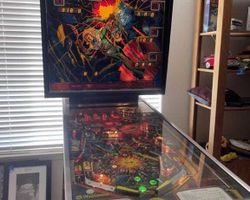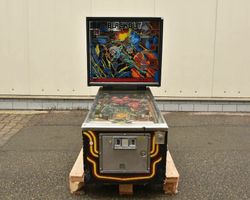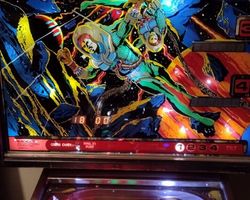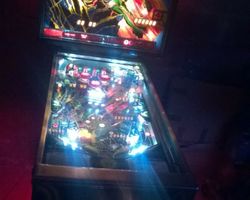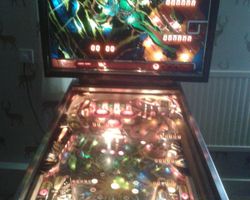Blackout
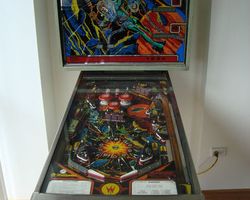
Average Prices: USD $200 to $1,200
Produced: June, 1980
Production Run: 7,050 units
Machine Type: Solid State Electronic
MPU: Williams System 6
Players: 4
Design by: Claude Fernandez
Art by: Constantino Mitchell
Released in the summer of 1980 by Williams Electronics, Incorporated, Blackout pinball plunged players into a thrilling space-themed disaster scenario. This machine, model number 495, emerged as a standout title within the burgeoning solid-state era of pinball, bearing the mark of the Williams System 6 platform. Designed during a period of rapid innovation in pinball technology and gameplay, Blackout offered a unique blend of engaging mechanics and striking visual and auditory elements that captivated players and solidified its place in pinball history.
History and Background
Blackout arrived at a time when pinball was evolving from electromechanical relays to solid-state electronics. Williams, a leading manufacturer, was at the forefront of this transition. Blackout, with its sci-fi theme, reflected the popular culture fascination with space and the unknown, a trend amplified by blockbuster movies and television shows of the era.
The creative force behind Blackout was a team of talented individuals. Claude Fernandez is credited with the game's design, crafting a playfield layout that would become influential, even appearing in variations in other manufacturers' machines. The visually arresting artwork, crucial for attracting players in arcades, was executed by Constantino and Jeanine Mitchell. Constantino Mitchell later revealed that the backglass art concept was initially conceived by his mentor, Ed Paschke, whose color usage significantly influenced the final artistic direction, even though the design was ultimately redone in Mitchell's style. The game's distinctive soundscape and software were the work of Paul Dussault, who also handled the French speech processing, adding a layer of auditory depth uncommon for games of its time.
Production of Blackout commenced in June 1980, with its official release in August of the same year. Approximately 7,050 units were manufactured, a respectable production run for a solid-state game of that era. Priced at a manufacturer's suggested retail price of $750, Blackout entered a competitive market, aiming to capture the attention of both seasoned pinball players and newcomers drawn to its novel features and theme. Interestingly, Blackout marked a subtle shift in Williams' cabinet construction; prior to its release, four bolts were standard for securing the backbox, but Blackout and subsequent models utilized only two, even when the steel was still stamped for the previous four-bolt configuration.
Signature Features and Design
Blackout is aptly named, with its most defining feature being the computer-controlled general illumination (GI) relay. This innovation, although predated by Stern's Galaxy by a few months, was a first for Williams pinball machines. The 'BLACKOUT' sequence, triggered during gameplay, plunged the playfield into momentary darkness by cutting power to all general illumination lamps, creating a dramatic and immersive effect. This feature was achieved by a relay mounted in the backbox, known as the G.I. Relay, adding a layer of technological sophistication to the gameplay experience.
Beyond the namesake feature, Blackout is visually striking. The mirrored backglass enhances the depth and dynamism of the artwork, drawing players into the game's sci-fi world. The playfield artwork continues this thematic consistency, employing vivid colors and futuristic imagery typical of 80s science fiction. The inclusion of speech synthesis was another noteworthy element for its time, contributing to the game's atmosphere and providing auditory feedback to players. The sound design, in general, was considered advanced for the era, featuring distinct sounds for spinners and a memorable background score that heightened player engagement.
Playfield and Mechanics
The Blackout playfield is a testament to efficient and engaging design, characterized by its fast flow and emphasis on shot accuracy. It features a symmetrical layout centered around rewarding shot-making. Key playfield elements include three pop bumpers strategically positioned to influence ball trajectory and maintain action. Two slingshots at the lower playfield propel the ball dynamically, adding unpredictability and speed.
A defining feature of the playfield is the presence of six standup targets and two banks of three drop targets each. These drop targets are central to the game's objective, with hitting them being crucial for triggering the 'BLACKOUT' sequence and advancing gameplay. Three spinning targets are incorporated, offering opportunities for skillful side shots and adding to the scoring potential. A single kick-out hole adds another element of ball control and recovery.
The playfield artwork complements the sci-fi theme, with bright, contrasting colors and graphics that evoke a sense of futuristic technology and cosmic events. The lighting design, beyond the 'BLACKOUT' feature, is integrated to highlight key playfield areas and create visual interest. The overall aesthetic is geared towards creating an immersive and visually stimulating environment that enhances the fast-paced gameplay.
Gameplay Dynamics
Blackout’s gameplay is centered around a clear and compelling objective: achieve 'BLACKOUT'. This is primarily accomplished by skillfully targeting and knocking down the drop targets. The game mechanics reward accuracy and timing, focusing on single-ball play without multiball features, which was common for games of this period. The scoring system is straightforward, with points awarded for hitting targets, activating spinners, and completing objectives.
The 'BLACKOUT' mode itself is a significant gameplay event. When triggered, the playfield lights extinguish momentarily, accompanied by sound effects, creating a dramatic shift in the game environment. This not only adds visual excitement but also changes the gameplay dynamic, requiring players to adapt to the altered lighting conditions.
While the ruleset is considered relatively accessible, Blackout offers depth through its emphasis on shot precision. Players are encouraged to develop strategies for consistently hitting the drop targets and spinners, maximizing their score and triggering the 'BLACKOUT' sequence repeatedly. Despite the absence of complex modes or layered rule sets found in later machines, the core gameplay loop of Blackout is engaging and addictive, providing a satisfying pinball experience rooted in skillful shot execution.
Reception and Legacy
Blackout has garnered a generally positive reception within the pinball community, often cited as an underrated gem from the early solid-state era. Players appreciate its fast and engaging gameplay, finding it both accessible to newcomers and rewarding for experienced players seeking a skill-based challenge. The artwork is frequently praised for its vibrant 80s sci-fi aesthetic and the mirrored backglass is recognized as a visually appealing feature. The sound design, including the speech and unique spinner sounds, is also highlighted as being impressive for its time, enhancing the overall immersive quality of the game.
However, some criticisms have been noted. The ruleset, while engaging, is considered relatively simple compared to more modern machines, which might lead to a perception of limited depth for some players after extended play. Concerns about scoring imbalances and potential score overflows have been occasionally mentioned. While the playfield art is well-regarded, the cabinet artwork has received mixed feedback, with some finding it less appealing. The lack of multiball, a feature that became increasingly common in later pinball designs, is sometimes noted as a potential drawback for those seeking more complex gameplay experiences.
Despite these minor criticisms, Blackout's legacy is secure. It stands as a significant example of early solid-state pinball design, showcasing innovative features like the computer-controlled GI relay and incorporating a strong thematic and artistic vision. Its influence can be seen in its playfield layout, which was adapted and reused in other pinball machines, demonstrating its foundational design principles. Blackout remains a fondly remembered and actively collected machine, appreciated for its blend of fast gameplay, striking aesthetics, and technological innovations that were at the forefront of pinball evolution in the 1980s.
 Active Auctions
Active Auctions
 Auction Results
Auction Results
| Cost | Location | Date |
|---|---|---|
| USD $1,700 |  Indiana, United States Indiana, United States |
02 February, 2025 |
| USD $1,000 |  California, United States California, United States |
27 January, 2024 |
| USD $1,900 |  Nebraska, United States Nebraska, United States |
05 January, 2024 |
| USD $1,800 |  Oregon, United States Oregon, United States |
12 May, 2023 |
| USD $2,400 |  Michigan, United States Michigan, United States |
24 April, 2023 |
| USD $2,100 |  Connecticut, United States Connecticut, United States |
10 March, 2023 |
| USD $2,500 |  Michigan, United States Michigan, United States |
05 January, 2023 |
| USD $1,425 |  Nevada, United States Nevada, United States |
17 November, 2022 |
| USD $1,650 |  Pennsylvania, United States Pennsylvania, United States |
11 October, 2022 |
| EUR €991 |  Bayern, Germany Bayern, Germany |
06 June, 2022 |


Private Policy · Search Website · Contact Us
All trademarks and copyrighted materials remain property of their respective owners.
All other content copyright 2007 - 2025 Pinpedia.

